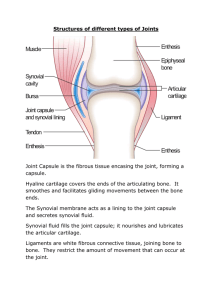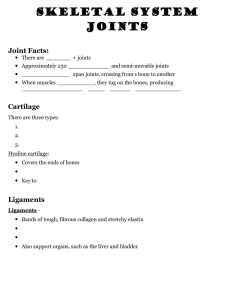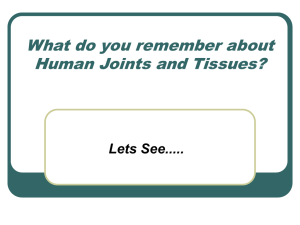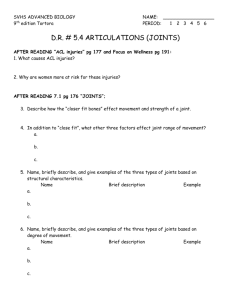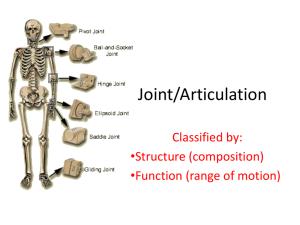Joints
Joints
Joints
• Occur where two bones meet
• Allow various ranges of motion?
• Are they found in only the appendicular skeleton?
Two ways to classify joints
• Range of motion
– Synarthrosis, amphiarthrosis, diarthrosis
• Composition of the joint
– Boney, fibrous, cartilaginous, synovial
Synarthrosis (immovable)
• Would these be strong joints?
• Examples?
– Sutures (skull bones)
– Gomphoses (teeth)
– Synchondroses (epiphyseal cartilages)
– Synostosis (epiphyseal lines of mature long bones)
Fibrous articulations
Synarthrotic
Amphiarthrotic
Amphiarthroses (slightly movable)
• Would these be strong?
• Joint is formed with collagen fibers or cartilage
• Examples:
– Syndesmosis (ligaments)
– Symphyses (separated by fibrocartilage; pubic symphysis, vertebral discs)
Diarthroses (freely movable)
• Are these joints strong?
• What is the key function?
• All diarthrotic joints are synovial joints
• Examples?
– Knee
– Shoulder
– Hip
Parts of articulations
Synovial joints
• Plane; slight movement
• Pivot; slight rotational movement in 1 direction
• Hinge; movement in
1 direction
Synovial joints
• Saddle; major movement in 1 direction; slight in another
• Ball & Socket; movement in
multiple axes
• Condyloid; 2 or more axes
Synovial joints have lots of structures
Bursa: Connective tissue pads
Meniscus: Fibrocartilage pads
Synovial fluid: proteoglycan-rich fluid for:
1. Lubrication
2. Shock absorption
3. Nutrient delivery
Compare shoulder & hip
Shoulder joint
• Most mobile joint
• Weakest joint
• Small ligaments hold shoulder together
• Small, thin muscles stabilize humerus
• Shallow joint capsule
Hip joint
Very Stable
• Acetabulum swallows head of femur
• Multiple ligaments wrap entire joint capsule
• Massive muscles stabilize position
Knee joint: complex
Knee joint
Elbow joint
Most stable: interlocking bones; single joint capsule; strong, wrapping ligaments
Joint Disorders
• Arthritis
– Rheumatoid arthritis: Affects connective tissues; most pronounced & crippling in joints of hands & feet
– Autoimmune disease (body attacks itself)
– CT cells of synovial membrane proliferate, grow into articular cartilage of bones; bones eventually fuse
Joint Disorders
• Arthritis
– Osteoarthritis: Natural degeneration with age and lack of exercise
– Gout: Accumulation and storage of crystals of uric acid (waste) in kidney & joints
• Most often affects base of big toe & other leg
& foot joints
Joint Disorders
• Sprains: pulled or torn joint stabilizing ligaments
– Results when bones of joints are pulled forcefully apart
• Dislocation: the end of one bone is pulled OUT of socket.
– Occurs in ball & socket, ellipsoid or pivot joints
• Cartilage injuries: “Hammering” on articular cartilage squashes and kills chondrocytes
Joint Disorders
• Bursitis: Inflammation of bursa
– Inflammation of bursae around shoulder and elbow is common
• Caused by muscle instability or underdevelopment
– Bursitis at base of big toe = Bunion
• Often caused by wearing shoes too tight
